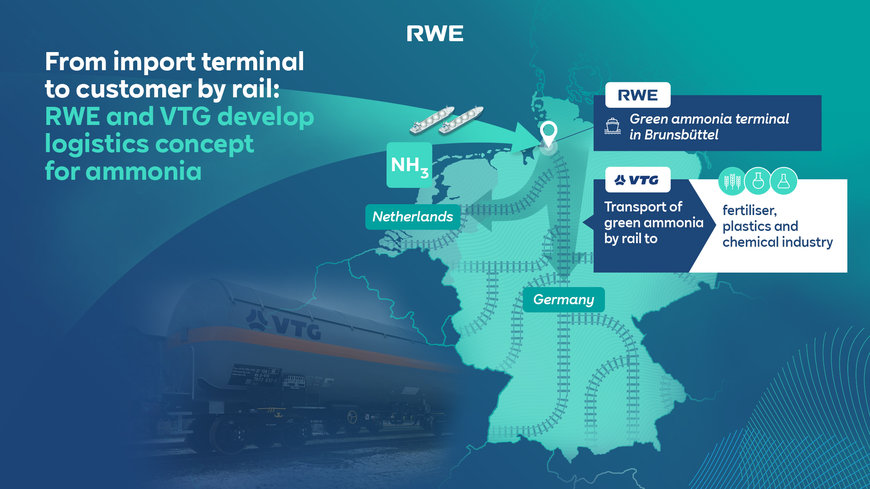RWE and VTG develop logistics concept for ammonia: from import terminal to customer by rail
News on RWE’s planned green import terminal for ammonia in Brunsbüttel: RWE plans to use rail transport for the onward journey of this fuel.

- Customers in Germany and the Netherlands can be reached without pipelines or inland ports
- Investigation of supply routes and required filling and transport capacities underway
To this end, the company is working with the global logistics company VTG to deliver the ammonia by tank wagon to customers in Germany and neighbouring countries. The two companies today signed a Memorandum of Understanding (MoU) to this effect.
RWE and VTG will jointly develop a logistics concept for supplying customers. This will include exploring delivery routes and determining the necessary filling and transport capacities. Rail transport is advantageous for industrial customers, as no connection to a pipeline or inland port is required. The delivery of ammonia by tank wagon has been an established method for years.
“Green ammonia is key in the energy transition because it can be used to decarbonise many industrial processes. In the future, Germany will import large quantities of ammonia, for example via the terminal planned by RWE in Brunsbüttel. From there, the molecules will be distributed directly to industrial customers. VTG has many years of experience in transporting ammonia by tank wagon. That’s why RWE and VTG are also jointly looking at distribution by rail,” says Ulf Kerstin, CCO of RWE Supply & Trading.
Sven Wellbrock, Chief Operating Officer Europe and Chief Safety Officer of VTG, adds: "In addition to its great importance as a basic material for industry, ammonia will also play an important role in securing energy supplies in the coming decades. It is part of VTG's New Energies strategy, which aims to provide our customers with the best possible support in the transformation towards sustainable industrial processes. Together with RWE, we want to show that large quantities of ammonia can already be supplied by rail in the short term in a low-emission and competitive manner."
To achieve the climate goals, demand for green molecules will increase strongly in the future. To meet the demands of industrial decarbonisation, Germany will need access to green molecules from other parts of the world in addition to its own hydrogen production. RWE is striving to develop a globally diversified portfolio of projects and offtake agreements for hydrogen and its derivatives, such as ammonia. In this context, RWE is also planning a green import terminal for ammonia in Brunsbüttel. From 2026, around 300,000 tonnes of green ammonia per year are to be landed here.
Ammonia (NH3) is a compound of hydrogen and nitrogen. It is considered one of the most widely used basic materials in chemistry. Some 180 million tonnes are produced worldwide each year and processed into fertilisers, plastics and other chemicals, among other things. “Green ammonia” is produced with hydrogen generated by electrolysis using renewable energy.
www.vtg.com

